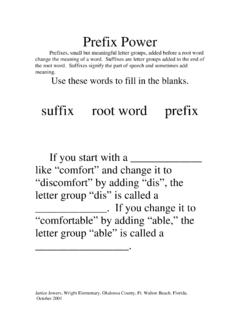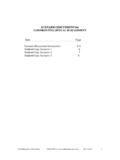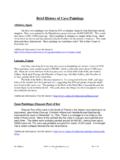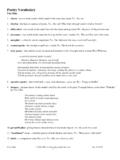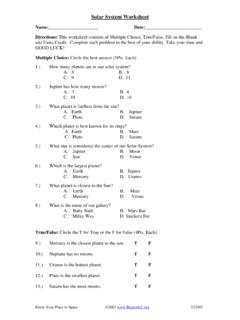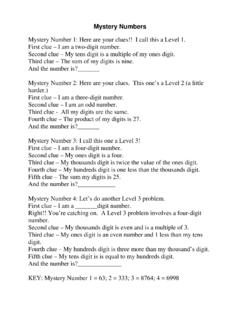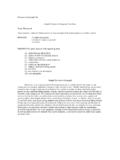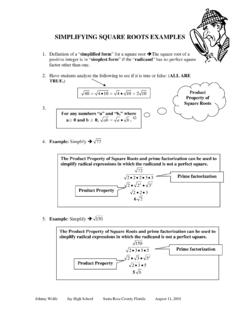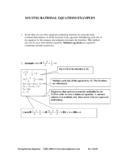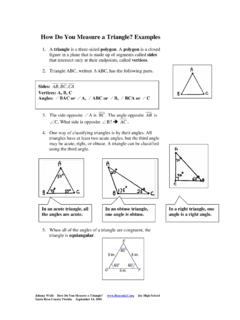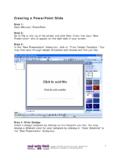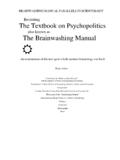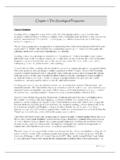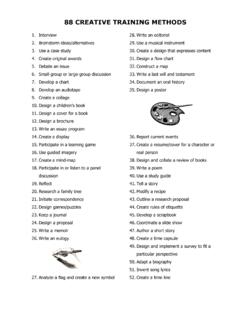Transcription of BIOGRAPHICAL RESEARCH REPORT - Beacon Learning Center
1 BIOGRAPHICAL RESEARCH Paper 04 1 BIOGRAPHICAL RESEARCH REPORT A biography is a true story of a person s life written by another person. Good biographers RESEARCH subjects extensively in order to present information accurately. The writer, or biographer, interviews the subject if possible and researches the person s life. Biographers often focus on remarkable or admirable aspects of their subjects. Although biographers often present their subject in a favorable way, they also strive for a balance between fact and interpretation. Usually, biographers also must decide which facts and which parts of a subject s life to include. An autobiography is an account of a person s life written by that person and usually told in the first person point of view using the pronoun I.
2 In an autobiography, the writer details significant events and people in his or her life. An autobiography is usually book length because it covers a long span of time. A shorter form of auto- BIOGRAPHICAL writing is a personal narrative, in which the writer focuses on a significant experience in his or her life. Other short forms of autobiographical writing include journals, diaries, and letters. This BIOGRAPHICAL RESEARCH can take various forms and can encompass a variety of Learning experi- ences. After choosing a subject to RESEARCH , get an overview of your subject by reading general articles in reference books, such as encyclopedias, BIOGRAPHICAL dictionaries, newspaper articles, magazine articles, films, videos, television programs, autobiographies, and biographies. A new approach to RESEARCH is to search the Internet for information.
3 After getting a general overview of your subject, you should develop a purpose statement, which is simply one or two sentences that states what you plan to accomplish in your paper. Write your purpose statement on a note card. This purpose statement will not actually appear in your final paper, but you may reword it as part of your introduction. Here is an example of a purpose statement for a biographi- cal RESEARCH paper: SAMPLE PURPOSE STATEMENT (I plan to tell about the life of Eva Duarte Peron and her political contributions to Argentina as the wife of President Juan Domingo Peron. I will tell how she helped Peron rise to power and became one of the most famous women of her day. ) ** The next step is to develop a preliminary outline to help guide your RESEARCH .
4 A preliminary outline BIOGRAPHICAL RESEARCH Paper 04 2 is simply an informal list of ideas to cover in your paper in the order that you plan to cover them. The headings in this first outline come from the general information gathered during the overview stage and from your purpose statement. The outline does not have to be detailed. Its purpose is to guide and organize your RESEARCH . As you begin your RESEARCH , you will probably find some subheadings that do not belong in this preliminary outline and discover new subheadings that should be added. Throughout your RESEARCH , you will add, delete, and rearrange material in the preliminary outline. Here is a sample outline for a BIOGRAPHICAL RESEARCH REPORT : SAMPLE OUTLINE The Life and Political Influence of Eva Duarte Peron I.
5 Early life A. Birth B. Family C. Education II. Early career A. Model B. Actress C. Radio actress III. Marriage IV. First Lady years A. Contact with the labor unions B. Eva Peron Foundation C. Women s branch of Peronist party V. Vice-presidency A. Her nomination B. Opposition to her candidacy C. Blockage of her candidacy VI. Death ** Write bibliographical information on separate note cards, one card for each source. Be sure to list source card letter, author, title, publisher, copyright date, pages,etc. for source used. This infor- mation will be extremely important as you prepare your final bibliography page, the Works Cited. (Refer to Source Card Handout to see how to enter information for various sources.) Take notes on material directly related to a heading or subheading in your preliminary outline.
6 For each note on a different heading or subheading, use a new card. Change cards also when you BIOGRAPHICAL RESEARCH Paper 04 3 move to a different source. Before taking notes, read quickly over the relevant material. You may take notes by summarizing, paraphrasing, or quoting. After your RESEARCH is completed, you need to prepare a final outline. Next, you sort through your note cards and arrange them in stacks referring to the main headings and subheadings of your final outline. After you have organized each stack, you should number each card and circle each number, beginning with the number 1. After you organize your note cards, you will be able to write your rough draft.
7 A rough draft is your first attempt to write in a logical order the material that supports your purpose statement. As you write, you may find that each item in your outline develops easily into one or two paragraphs. However, you may also find that you lack sufficient details on a particular topic and you must do more RESEARCH . If so, stop immediately and gather the additional information before you continue your first draft. When writing your rough draft, you should pay close attention to documenting sources and incorporating quotations by using the MLA style. (Refer to grammar book and other suggested MLA reference guides.) Be sure that your paper has an introduction and a conclusion. Although the introduction does not appear as a heading on your outline, it is nevertheless a very important part of your paper. The intro- duction should catch the reader s interest.
8 It should clearly indicate the topic and your purpose in writing about it. The thesis statement (your purpose statement in its revised form) is often the last sentence in the introduction. Here is an introduction for the subject in the sample outline: SAMPLE INTRODUCTION Eva Duarte Peron was the second wife of President Juan Peron of Argentina. Eva, also called Evita, helped Peron rise to power. She became a favorite of her country s citizens and an influential, although unofficial, member of Peron s government. Her own experiences with the working class enabled her to act capably as her husband s political liaison with labor interests, women, and the poor. She became one of the most famous and influential women of her day.
9 ** BIOGRAPHICAL RESEARCH Paper 04 4 The body of your paper states and develops the main ideas in your outline. The conclusion, or the last paragraph of your paper, leaves a final impression about your subject. That impression should give the paper a sense of completeness by reinforcing the main idea expressed the thesis statement. The conclusion should make a final statement that is an extension of the points discussed in the body. Here is an example of a concluding paragraph about the subject in the sample outline: SAMPLE CONCLUSION As a result of Eva Peron s social welfare work with Argentina s disadvantaged, she was affectionately known and remembered by the diminutive Evita.
10 Evita was the second most influential figure in Argentina and the mainstay of her husband s support. Evita s death, economic difficulties, increasing labor unrest, and his excommunication from the Roman Catholic church, further weakened Peron s government. In 1955, three years after Evita s death, he was ousted by the military. After eighteen years of exile, Peron was allowed to return to Argentina in 1973 and was elected President, with his third wife, Isabel, as Vice-president. ** By evaluating your rough draft, you identify the strengths and weaknesses of your paper. To make the changes necessary to improve your paper, you should analyze each problem that I noted on your rough draft. You can revise by adding, cutting, reordering, and replacing. Proofread your paper for errors in usage, grammar, and mechanics.
